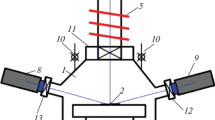Abstract
A simple method for patterning of thin (15–650 nm) aluminum films on glass substrates by direct, low-power, laser-thermal oxidation in water under common laboratory conditions is demonstrated. Local heating of the metal film enhances the formation of aluminum oxide (hydrargillite, Al2O3–3H2O) and provokes breakdown of the passivation layer followed by local corrosion at temperatures close to the boiling point of water. Moving the focus of an Ar-ion laser (λ=488 nm) over the aluminum film with a speed of several μm/s yields grooves flanked by hydrargillite. Upon through oxidation of the metal these structures act as electrically insulating domains. Depending on the film thickness, the minimum width of the line structures measures between 266 nm and 600 nm. The required laser irradiation power ranges from 1.7 mW to 30 mW. It is found that the photo-thermal oxidation process allows for writing of two-dimensional electrode patterns.
Similar content being viewed by others
Author information
Authors and Affiliations
Additional information
Received: 16 July 2001 / Accepted: 23 July 2001 / Published online: 2 October 2001
Rights and permissions
About this article
Cite this article
Haefliger, D., Stemmer, A. Structuring of aluminum films by laser-induced local oxidation in water. Appl Phys A 74, 115–118 (2002). https://doi.org/10.1007/s003390100974
Published:
Issue Date:
DOI: https://doi.org/10.1007/s003390100974




